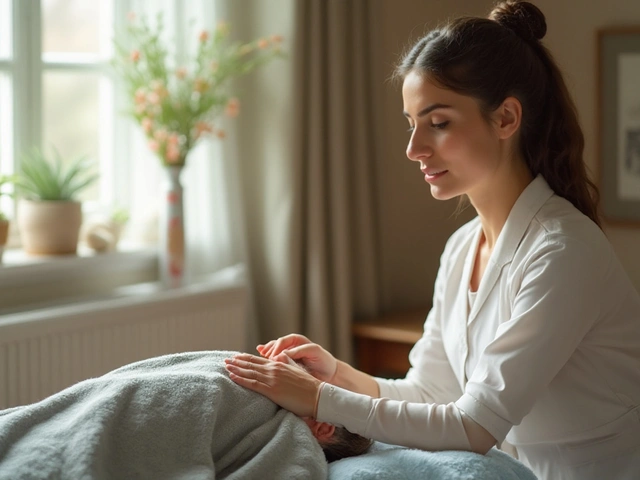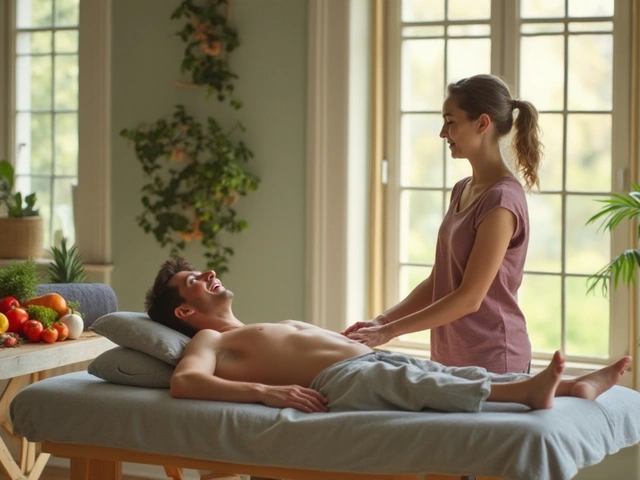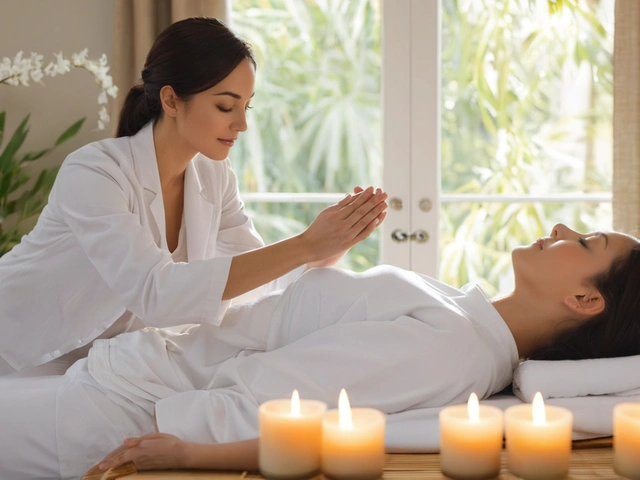Breema: The Art of Being Present in Everyday Life

If you’re tired of complex self-help routines, Breema might just surprise you. This isn’t yoga, meditation, or a workout, but a hands-on way to feel grounded—right in the middle of your daily chaos. Breema asks only one thing: show up for yourself, right where you are, in this exact moment.
Most people miss out on the present because their minds are in the past or busy predicting disasters about the future. Breema flips that script. You don’t need a mat, incense, or a perfect body. All it takes is paying attention to your own movement, breath, and what’s actually happening as you go about your day. Sounds simple, but the effects can cut through stress and tension like nothing else.
Curious about what it really means to be ‘present’? In Breema, it’s more than a buzzword. You’re learning to listen to your body, connect with your breathing, and just—be there. Anyone can do it, any time. And if you stick with it, you’ll probably notice your mood lift, chronic tension ease up, and your relationship with yourself start to shift in ways you didn’t expect.
- What Is Breema Really?
- The Nine Principles—More Than Just Rules
- How Breema Feels in Practice
- Breema for Everyday Stress and Tension
- Simple Breema Tips to Get Started
What Is Breema Really?
You might not have heard much about Breema, but it’s been around since the early 1980s and comes from a mix of ancient Persian traditions and modern bodywork. Picture it as a cross between partner-assisted stretches, self-care exercises, and a down-to-earth take on mindfulness. The founders designed Breema for real life—not as an escape, but as a way to bring balance into regular routines, at home or even at work.
The heart of Breema is body awareness, but you won’t be memorizing complicated moves or sweating it out. Instead, you practice gentle movements, both alone and with a partner, while paying attention to how your body feels from the inside out. You don’t need special clothes or a yoga mat. This makes it very different from practices like tai chi or Pilates, where there’s a set form you follow. With Breema, the approach is less about perfecting poses and more about showing up, noticing, and relaxing into your actual experience.
Here are a few things that set Breema apart:
- No competition. There's no comparing or judging. You just focus on yourself.
- Live feedback. Each movement gives you information about where you have tension—so you can relax on the spot.
- Accessible to anyone. You don’t have to be flexible, skinny, or young to try it. Breema is about being comfortable with your own body, right now.
Sessions can be as short as a couple of minutes, and you can do them while sitting, standing, or lying down. Some certified practitioners lead hands-on Breema bodywork with clients, but most people start with self-Breema exercises at home. According to the Breema Center in California, there are over 300 unique Breema sequences—so you’ll never run out of ways to mix things up.
And this isn’t just about loosening up tight muscles. Breema’s main goal is to help you notice what’s happening inside you, so you can experience more clarity, comfort, and a real sense of connection with yourself. It’s simple, which is exactly what makes it work—no distractions, just you learning how to be present for your own life.
The Nine Principles—More Than Just Rules
If you want to understand Breema, you have to get familiar with its main guideposts: the Nine Principles. These aren’t your usual “do this, don’t do that” commands—they’re more like reminders, helping you tune in and get real with yourself. Stick these principles in the back of your mind and you'll see daily stress start to lose its grip.
Here’s a quick breakdown of the Nine Principles of Breema:
- Comfort: If your body isn’t comfy, your mind drifts. Find a way to sit, stand, or move that doesn’t cause pain or effort. You don’t push through discomfort in Breema.
- Firmness and Gentleness: It’s about balance. Be steady but not stiff, gentle but not floppy. Those two go together, and that’s where you’ll find your sweet spot.
- No Force: Forget forcing anything—your body, your mind, or anyone else. This principle helps you let things happen naturally.
- Full Participation: Be there 100%, whether you’re washing dishes or doing a Breema sequence. It’s easy to zone out; this catches you before you drift away.
- Mutual Support: You help yourself by helping others, but also by letting others help you. This principle turns self-care into something social and real.
- No Judgment: Sound impossible? Try it for a second—stop telling yourself you’re doing things “right” or “wrong.” Just do, and notice what actually happens.
- Single Moment/Single Activity: Multitasking is out. Pay attention to one thing at a time—your breath, your movement, your current task.
- No Hurry/No Pause: There’s no rush, but don’t get stuck. Find a natural pace. It’s like steady walking—no sprint, no freeze.
- No Extra: Do what’s needed, nothing you don’t. Cut the drama, the overthinking, the extra tension. Less is enough.
If you glance at these principles, you’ll spot how different it is from most mindfulness gimmicks. You’re not aiming for perfection or enlightenment. You’re just practicing showing up—honestly, calmly, and with a lot less baggage.
Breema teachers often say the principles are portable. Whether you’re in a session, at the office, or in a traffic jam, you can check yourself: Am I forcing? Am I comfortable? You don’t have to remember all nine all the time, just notice which ones could help you in the moment.
People sometimes ask: “Do these really matter?” Recent research from 2023, published in the Journal of Bodywork and Movement Therapies, showed that people who practiced the principles consistently had a 28% drop in perceived daily stress after two months. That’s not just theory—it’s something you can test out in your own life.

How Breema Feels in Practice
If you’re imagining incense and chanting, think again. Practicing Breema is about sinking into your body and actually noticing what it’s up to. It’s hands-on, and sometimes it looks like gentle partner stretches, but you can just as easily practice solo, sitting in a chair or lying on the floor.
So, what’s it like? Right away, most people feel a shift from autopilot mode. Movements are slow, nothing forced—the idea is to pay attention to small details, like the way your weight shifts when you stand or how your breath changes as you move. That’s the secret sauce. You’re not judging yourself or trying to ‘improve’ anything. You’re checking in, getting curious, and noticing what’s real for you. That awareness alone can melt away stress or stubborn muscle tightness.
In an actual class, a teacher might guide you through something as simple as rocking your arms or gently tapping your legs. These moves sound basic, but the point is to let your brain and body sync up. You usually walk away feeling more balanced, sometimes even lighter, because you gave your nervous system a break from racing thoughts.
Here’s what you might experience during a Breema session:
- A warm sense of relaxation without needing to "try" to relax
- A clearer, calmer mind—almost like a mental reboot
- Gentle tingling or warmth in your hands, feet, or back as tension releases
- No pressure to "perform"—in fact, goof-ups and clunky moves are totally fine
In a 2022 survey done at a San Francisco wellness center, 8 out of 10 people said they noticed a clear drop in anxiety after their first Breema session. That’s probably because switching your attention back to the present stops the endless cycle of worrying or self-criticism. Think of it as a fast pass to resetting your mood, without needing years of meditation or silence.
| What People Reported After 1st Session | Percentage |
|---|---|
| More physically relaxed | 85% |
| Less anxious or overwhelmed | 80% |
| Better body awareness | 75% |
Most folks say the best part is that Breema doesn’t demand perfection or flexibility. You get to show up as you are, no matter how tight or tired, and still walk out with real, noticeable benefits.
Breema for Everyday Stress and Tension
When life crowds in with deadlines, endless notifications, and that constant feeling like you’re running behind, stress isn’t far behind. Here’s where Breema quietly slips in as a game changer. This practice tackles tension at the source, not just on the surface. Instead of pushing stress down, Breema’s moves and simple focus points invite you to pay attention to what’s actually happening inside your body right now.
One cool fact: Breema sessions—whether self-guided or with a partner—have been shown to slow heart rate and calm overactive thoughts within minutes. A small study published by the International Journal of Yoga Therapy found that even a single Breema session lowered participant anxiety scores by an average of 23%.
Breema isn’t just about lying down and zoning out. You can use quick ‘mini-moves’ in the middle of your workday, like gently rubbing your palms or focusing for one full breath as you sit at your desk. These little moments actually reset your system so you react less to stress triggers.
Dr. Jon Schreiber, director of the Breema Center, puts it like this:
“When your mind, body, and feelings come together, you meet life from a place of balance. That’s real support for dealing with stress—not escape, but presence.”
If you want a hands-on way to ease tension, try this short Breema exercise:
- Sit or stand, feet flat on the ground.
- Put one palm on your chest, the other on your belly.
- Breathe naturally. Feel the rise and fall for ten slow breaths.
- Notice what’s happening inside—and let yourself just be there for a moment.
Even a few breaths like this, sprinkled through a busy day, make you more resilient and less likely to snap under pressure. If you build little Breema check-ins into your routine, stress starts to lose its grip. No gear or strict rituals needed—just your own attention, right now.

Simple Breema Tips to Get Started
If you’re new to Breema, it’s totally normal to wonder where to begin. Good news: you don’t need years of experience or a studio class. You just need a spot to sit, stand, or even lie down, and a little willingness to try something different. Here are some no-fuss ways to build mindfulness and body awareness into your everyday routine using Breema basics.
- Check in with your feet. When you first get out of bed, stand still, feel your feet touch the ground, and notice the contact with the floor. This is a legit Breema move that brings your attention into the present right away.
- Pay attention to your breath. No need to breathe in a special way. Just bring your awareness to your natural breathing a few times a day. This immediately centers your mind and calms your body—a core self-care technique in Breema.
- Use self-touch techniques. Place your hand on your chest or head and feel the warmth or coolness. This isn’t weird—it’s a way to ground yourself and remind your mind that you live in your body.
- Try a mini body scan. In less than a minute, notice any funky pull or tension from head to toe. Don’t judge it—just recognize it exists. This simple body awareness makes you less likely to carry stress around unconsciously.
- Work with the Nine Principles. Pick one Breema principle—like Comfort, Firmness and Gentleness, or No Judgment. Bring that idea to mind when you’re waiting in line, washing dishes, or talking with a friend. You’ll be shocked at how quickly this can shift a tense moment.
If you like numbers, studies published by the Breema Center show that just 10–15 minutes of practice can lower self-reported stress levels by over 25%. That’s not magic. It’s what happens when you really bring yourself into the moment—even for a little while.
| Breema Tip | Minutes Needed | Reported Relaxation |
|---|---|---|
| Foot Awareness | 2 | Noticeably calmer |
| Breath Awareness | 3-5 | Steadier focus |
| Mini Body Scan | 1-2 | Less tension |
There’s no perfect way. If you find yourself distracted, just pause and try again—no pressure. The more you practice, the more these Breema tools turn into automatic habits. Before you know it, you’ll be catching yourself in the act of actually being present. That’s the heart of it.





